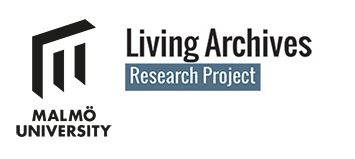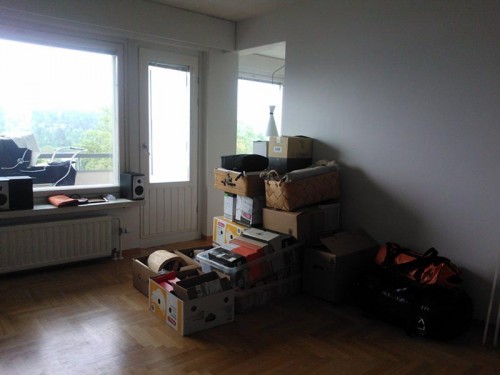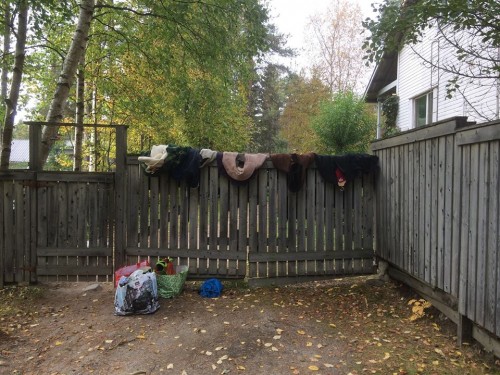When you move from one apartment to another, you are forced to face all your belongings – from the piano to the smallest pieces of chewing gum. You have to decide what to take to the new location, and what to do with the rest. This “gap in accommodation” is the starting point in Veera Kinnunen’s presentation where she explores how we deal with things and memories.
This is a revised version of an “inspirational lecture” presented at the Living Archives seminar Levande Minnen, 23 September, 2014. It is based on an article being prepared for publication in Things to Remember: Materializing Memories in Art and Popular Culture conference. Veera Kinnunen is a doctoral candidate at the University of Lapland, Finland.
Managing Things, Managing Memories
Text: Veera Kinnunen.
The absolutely shittiest thing about moving is packing up the old stuff and throwing out your spare junk. If you don’t have the guts to throw out your lecture notes from 2003 or old article copies, or if you have been storing something bigger under your roof, you are definitely in trouble. (Female, SKS)
My presentation today is based on my ongoing doctoral research which goes by the working title “Moving with things” in which I study living with things from the perspective of materially oriented sociology.
Acquiring and using things in the domestic domain has been quite thoroughly researched by material culture studies and consumer studies. My focus is on a less researched side of consuming, disposing of things. As we all know from experience, things have a tendency to multiply; we buy, find, and inherit new items all the time. Some of the material stuff surrounding us is easily disposed of, but most of the things are meant to be saved, and getting rid of them is not as easy as acquiring them. Nevertheless, the ideal domestic environment is often represented, at least in glossy magazines, practically clutter free. In order to keep our houses nearly as neat and empty, we need to work really hard to keep the stuff invisible. In my study I am not interested in discarding disposable items, but these not-easily disposed durable things. I will ask, for instance, how and when does one discard a present or a keepsake? In today’s presentation, I will be talking about divesting meaningful items, especially the meaning of divesting for remembering.
I will first briefly discuss why it is relevant to study moving house in order to understand things. Second, I will introduce the empirical data of my study and discuss how meaningful items are divested and possible reasons for why they are divested.
Moving as a gap in accommodation
When moving you are forced to settle accounts with your past; to go back to things that you have long ago buried in your cellar or in the back of your drawer. You have to decide what you really need and what it’s time to let go. (Female, SKS.)
When I first became interested in the object-relations with domestic possessions, my starting point was the Latourian (see, e.g., Latour 2005) idea that the normally invisible role of material ‘stuff’ in our daily lives becomes visible when the taken for granted routines are broken. The ultimate examples would be losing a house in a fire or being forcefully evacuated. Moving house is a more common event in the individual’s life that breaks the normal routines of dwelling. When moving, people are forced to face all their things, from a piano to the smallest pieces of chewing gum, and they have to decide what to take to a new location and what to do with the rest. I call this moment of confronting things ‘a gap in accommodation’ following Nicky Gregson (2007), a british ethnographer who has studied the disposing of things in a domestic context.
Nicky Gregson says that things enter the gap when they are handled, for example when cleaning, renovating or, indeed, moving, as in my case. In the gap the things are seen and thought about and thus they open up for research as well.
Today, my focus will be on what I have identified as the first phase of moving: the process of sorting out before the actual change of residence. I will have a look especially at how memories are sorted out at the same time as when the things are sorted through. I have been reading the data closely, asking what is considered worth keeping and for what reasons? What is done with unwanted things? How, why, and when is a memory object divested, or can it be divested?
The key concept of this paper is the notion of divestment which is a quite useful concept in its broadness because it means both passing significant objects between generations and the mundane act of wasting things. Divesting usually refers to passing on, but it also includes destroying, donating, selling, abandoning, or just throwing in the bin. The notion of divestment also implies that most discarding is not destroying but, rather, moving along (see Hetherington 2004). Things do not cease to exist, they travel.
The empirical data and the analysis
The data of my study consists of three parts: (1) The results of a writing competition that was organized with the Finnish Literature Society (SKS), which is the oldest cultural organization in Finland and which has been gathering oral history for over 150 years. The writing competition resulted in about 600 pages of written text. I will refer to them as the SKS collection. (2) Diaries written during the process of moving house. (3) Ethnographic interviews and participatory observation conducted during the processes of moving house. That means that I have volunteered as a removal help for people and I have documented the process of moving before, during, and after the actual change of residence. This is still in process, most of it have been conducted during this summer. Most of the empirical data that I am referring to is based on results of the SKS collection.
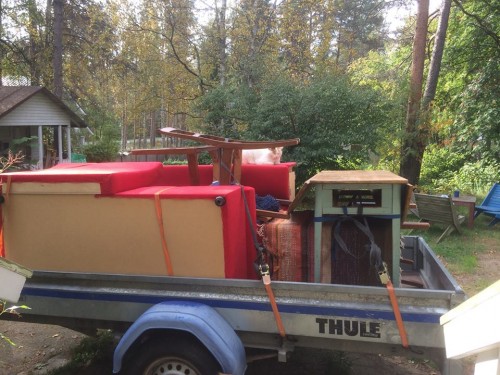
Figure 1. “Moving is a refreshing change. We’d be blocked up and stuck in our lives without moving every once in a while. For us, moving is a lifestyle. Moving in itself and new environments shape us in this continuous stream of change.” (Female, SKS)
The relationship of divesting and memory
Since childhood, I have never lived in the same house, or even the same town, longer than four years. That’s why I have collected a lot of personally meaningful things in my summer cottage. (Female, SKS)
Before I go to empirical findings I will say a few words about the material objects in relation to the act of remembering in general.
Marcus Kwint (1999, 2–3) has identified three main ways that objects serve memory in Western cultures. First, they furnish recollection by constituting the picture of our past. Our memories often cling to images of things and their qualities. We might remember what our childhood home’s curtains looked like. Second, objects stimulate collective and private remembering through public monuments or personal souvenirs as well as through sensory experiences that stimulate involuntary recollection. This latter experience has been explored by Marcel Proust in his often quoted madeleine-cake episode. Proust describes how taking a bite of a madeleine cake dipped in a lime-blossom tisane immediately throws him back to his childhood. Third, objects form records that store information beyond individual experience in a multiple of ways. This means that not only humans remember, but objects too: the memory sticks, books, and diaries carry our memory, remember with and for us, often better and more accurately than us. But not only memory sticks or diaries remember, all material remnants of the past form a living record of memory in their own, non-textual ways.
It is common to make an intuitive distinction between things in everyday use and consumption and sacred ‘memory devices’. Memory devices are things that have value in narrating a life and they form the core of material memory which is eventually passed between the generations. It is usually thought that these memory devices can never be thrown away. But, as we know, even significant things tend to multiply and leak out of their cupboards! Even they require an inventory every once in a while.
It is also important to notice that not only confronting significant, sacred objects, specialized to carry memories – such as photo albums or old baby shoes – act as memory triggers, but so do mundane everyday items. This becomes clear when something dramatic happens, such as a break up or the death of a loved one. When those unexpected tragedies happen, every item becomes a potential memory device: “this pillow smells just like dear old Karl”, or “this is the tea pot that we always drank tea with grandma”. Hence, memory devices and other objects surrounding us in our everyday lives cannot be separated. Things are powerful affects in which meanings, time layers, and memories of places and people etc. are entangled. That is one of many reasons why discarding domestic objects is often difficult and they cannot be thrown into the trash without hesitation. To be able to let singularized things go, people invent all kinds of ways to smuggle things out of their overflowing cupboards.
Of course it must be remembered that memory is not a tangible, fixed object that can be stored in a box (not even in a memory-box) – that is, there are no memories in a memory-box unless there’s someone to tell the story or experience an unexpected moment of recollection. Cultural memory studies see remembering as an act which is rooted in the present – being constantly retold and remolded, re-experienced (as the word ‘recall’ actually reveals).
Things have the capacity to even trigger involuntary memories. They can carry with them evidence from the past, which can be actualised when their paths cross with humans.
I started my research with the assumption that the “gap in accommodation”, the act of handling things, works as a memory trigger, meaning that handling things activates memories in all the three ways that Kwint has described. Thereby, when sorting out things one is also sorting out memories.
When sorting out things and memories, how are meaningful things divested, then?
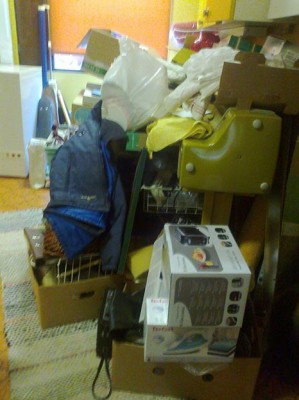
Figure 2. “Every corner of our house is filled with clutter. Even our two garages. We have named them Junk room number one, Junk room number two and so forth. – This is a picture of one of our Junk rooms; our son’s old room.” (Female, retired, SKS)
Every corner of our house is filled with clutter. Even our two garages. We have named them Junk room number one, Junk room number two and so forth. – This is a picture of one of our Junk rooms; our son’s old room. (Female, retired, SKS)
…by putting them in abeyance…
I will start the analysis of divesting by talking about storing. Significant objects are things that cause placing problems while moving because they are not easily thrown out, but there is often no room or immediate use for them. The solution seems to be to make them absent from the everyday life by separating them from the lived space: to a barn, parent’s house, a cottage and so on.
Kevin Hetherington (2004) redefines disposal by noting that disposal is not only about throwing things away but also about forgetfulness; maintaining things in a state of abeyance meaning “a state of not happening or being used at present.”
Many of the memory devices, for example diaries, letters, or childhood memories, are sentimentally valuable things that are kept in a state of abeyance without ever thinking of disposing of them. They form a sort of a domestic archive that serves to preserve them but not to have them publically viewed.
The trouble with putting surplus things in abeyance is that they need to be actively held in a state of absence. Even a small transformation in a status quo can force them back into consciousness, for example a change of residence or even just a thorough clean-up brings them back into the gap of accommodation. In the gap they are re-evaluated again: sometimes they have transformed while being in abeyance, gotten moth-eaten or molded or otherwise lost their sentimental value and they can be divested or they might be be stored again.
Kevin Hetherington compares disposing of things to Roberts Hertz’s famous anthropological study on funeral practices. Hertz was able to show that in many cultures, the burial rituals take place in two stages. The first ritual is for burying the soul and the second ritual for disposing of the material corpse. According to Hetherington, disposal of things often takes the same double-take form: not only the material object but also its value is disposed of. Often the storing of significant objects into garages, summer cottages, barns, and “junk rooms” acts as the first burial which disposes things of their value (be it use-, exchange-, or sentimental value). They are kept in these “transition places” (Lastovicka and Fernandez 2005, 817) until they have exhausted from their value, and the disposal can be finalized with the second burial (Hetherington 20004, 169).
Divestment works as making present love relations. One of the ways was to offer these transition places for the loved ones to save their spare things. In the writing competition texts, this obligation to offer storage room for children was mostly met with a frustration: as all the spaces were filled with unnecessary objects, you can imagine that they were not too happy to accept even more from their offspring. Above photo (figure 2) was sent by one of the elderly writers sent along with her text. She writes that every corner of her and her husband’s home is full of junk and clutter. Her husband loves gadgets and does not know what recycling is for. He just stores their broken machines into spare spaces that they have started to call “junk room number 1”, “junk room number two“, etc. And on top of that their daughter brought her stuff when she last moved “just for a moment”. She writes that she is fatally ill and is going to die soon, her only hope is that she will have time to clear out the mess before she dies.
…by giving to significant others…
A wardrobe was taken out from our hall. We are going to loan a trailer and take it to my mother’s who lives 270 kilometers from us. – I’m so happy that we found some use for it. (”Reetta”, a moving diary)
The most obvious way to make present love relations while getting rid of things is to give things. Sorting out while moving house is often a chance to pass on the memory objects. Usually meaningful memory objects are given to the family and other close ones. The French Canadians have a ritual called house breaking party, an event in which a moving person distributes her things to significant others (Marcoux 2001).
The house breaking event can be seen as a way of constructing oneself in the family memory by distributing things. The gift is never neutral; it always forms a relation between the giver and the givee. By giving significant things to significant others, one gives of him/herself (Pyyhtinen 2014).
The sad thing is that these gifts of oneself are not always accepted. The SKS collection texts described the joy of giving, of things “finding a new home”, but what was more striking was sorrow over the fate of the things that were turned down. Many elderly writers were afraid that their children would not accept their material heritage, not even the photographs when the time will come – “because they have the computers”, as one of the writers in the SKS collection put it.
The house breaking ritual has also been interpreted as a ritual in which a person tries to gain continuity or even immortality by donating his/her possessions to significant others. Following this line of thought, turning down a gift is turning down the giver and denying him/her the future continuity.
The fact that their things are not accepted by their offspring seemed to be a commonly shared grief in my data. These gifts are also a burden for the offspring, they have some kind of a moral obligation to accept the gift that they are offered, but they either already have enough things and no more room, or they just simply refuse to collect material stuff in their lives: “If my daughters ever fight over my inheritance, it will be over which one does not have to accept it.” (Female, SKS)
…by donating to a museum…
We have thousands of photographs and slides. Our children don’t want them because they have computers! During the past years, I have given photographs to the children, especially grandchildren. I have called the [provincial] museum and they will have some of them. (Female, SKS)
If passing the memory devices, such as photographs, is not possible or successful between generations, they are sometimes offered to a museum and thus the private memory devices are turned into collective commemorative ones. Writers in my data were thinking of donating their photographs or old handicrafts to a local museum if their children would not accept them.
By divesting objects into a museum, one is also freed from the future handling of them: The activeness of holding things absent. This job will be done by professional absentkeepers in ideal institutionalized conditions. One might even think of fulfilling ones duties towards the society by donating one’s personal mementos and memories for public use. Disposal of memory devices is thus turned into a societally meaningful act.
Since not all the significant items can be donated to a museum, the archives simply lack space, I see here a challenge for service designers to solve how to help people, especially elderly people, to divest their material things decently and respectfully. Could it be a material heritage service that would both help to record the memories concerning the items and to document them appropriately, and possibly also to look for “heirs” so that it could be possible to give and donate to strangers with a feeling – or at least an illusion – that the item goes to a good home, to a person who would respect the memory of its owner and who knows the history and meaning of the item. Or could we create a service that would capture the memory, the stories of the items before they were ritually destroyed? Possibly the Levande Minnen project’s scrapbooking idea could be utilized for this? The act of scrapbooking could be a sort of first ritual burial before the actual disposal of the item.
…by destroying…
The lesson of the story: don’t collect photographs, or anything else for that matter, at least not for your children! My daughter says that it’s been my hobby, but it’s no help. I’m already grieving over having to burn them. (Female, retired, SKS.)
Sometimes memory objects are so intimate and personal that they cannot be given to anyone. For example old diaries and photographs were kept in abeyance in the storages or cupboards. The only way of getting rid of them would have been total ritual destruction. In my data this was usually fulfilled by burning. Also if the close ones were not accepting for example the photographs as their material heritage (as in the quote), the photographs would have to be burned.
(Re)Inventing Memories
I will next examine briefly why and in what kinds of situations meaningful memory items were divested in my data:
I have sorted out a lot of stuff when I have moved. I have a functional rather than sentimental relationship with my furniture and other possessions. I don’t easily hoard too much possessions. There’s always a thought in the back of my head that it will be easier to move again if I don’t own too much stuff. All my memories, including childhood drawings, photos and so on, go into a couple of cardboard boxes. (Female, SKS)
A change of residence in itself is a major transition in life and as such it also opens up an opportunity for change in a larger sense. It is a tempting possibility to start over again and to mold life into better. This molding does not apply only to the future but also the past. The sorting-out process is a chance to update and choose what kind of material memories are gathered in the home, to decide which memories or relationships to keep, and which ones to abandon or put on hold.
Sorting out ones possessions can be taken as a therapeutic work when recovering from a serious life crisis such as a death in a family or the ending of a relationship. By getting rid of things, one gets rid of the traces of people and events that are too painful to recall. And the other way round: To save things is to choose to remember.
Moving often, or moving to a smaller apartment, also forces one to concentrate material memories into a few most important memory devices. For example, books are often turned into memory devices as they are the only ones that one carries with him/her across the continents. A woman described her emigration to Italy: Apart from the children’s toys and clothes, she had decided to include only Finnish books into her removal container, since furniture would be easier to replace “with cheap IKEA furniture”. The fact that books were the only things that reminded her of her home country made them all the more meaningful.
Conclusion: Making the choice of remembering
Moving unsettles the conventional ways of seeing and being with things. Even if one tries to save everything as they were, just being situated into a new environment has changed them, turned them into something new. The value of memory devices and singularized objects is reevaluated along with all the other things in the household.
Memory devices are divested in many ways and are divested for many reasons.
People do not divest things only because they do not matter. Some things are divested because they matter. Memories might be cumbersome or too painful. Or one divests of meaningful things by giving them to the close ones and thus transferring part of herself along with the gift. It is also important to notice that things are not simply given as mattering from the beginning. They may also come to matter through the sorting out – even mundane things sometimes acquire value in the sorting-out process.
Literature
Gregson, Nicky (2007) Living with things. Ridding, accommodation, dwelling. Sean Kingston Publishing, Wantage.
Gregson, Nicky, Metcalfe, Alan & Crewe, Louise (2007) Identity, mobility and the throwaway society.
Environment and planning D. Society and space 25:4.
Hetherington, Kevin (2004) Seconhandedness: Consumption, Disposal and absent presence. Environment and Planning D. Society and Space 22.
Kwint, Marcus (1999) Introduction: The Physical Past. In Kwint, Marcus, Breward Christopher & Aynsley, Jeremy (eds.) Material Memories. Berg, Oxford & New York, 1–14.
Lastovicka, John L. & Karen V. Fernandez (2005) Three paths to Disposition: The Movement of Meaningful
Possessions to Strangers. Journal of Consumer Research 31.
Latour, Bruno (2005) Reassembling the social. An introduction to Action-network-theory. Oxford University
Press, Oxford.
Lehtonen, Turo-Kimmo (2004) Aineellinen yhteisö. Tutkijaliitto, Helsinki.
Marcoux, Jean-Sébastian (2001) The “Casser Maison” ritual. Constructing the Self by Emptying the Home. Journal of Material Culture 6:2, 213–229.
Marcoux, Jean-Sébastian (2001) The Refurbishment of Memory. In Miller et. al. (eds.) Home Possessions:
Material Culture Behind Closed Doors. Berg Publishers, 69-87.
Pink, Sarah (2012) Situating everyday life. Sage.
Pyyhtinen, Olli (2014) The Gift and its Paradoxes. Beyond Mauss. Ashgate.
Serres, Michel (2010) Malfeasance. Appropriation Through Pollution? Stanford University Press, Stanford.
